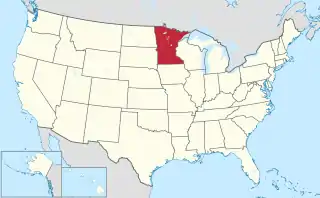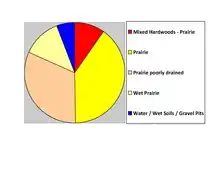Stevens County, Minnesota
Stevens County is a county in the U.S. state of Minnesota. As of the 2010 United States Census, the population was 9,726.[1] Its county seat is Morris.[2]
Stevens County | |
|---|---|
 | |
 Location within the U.S. state of Minnesota | |
 Minnesota's location within the U.S. | |
| Coordinates: 45°35′N 96°00′W | |
| Country | |
| State | |
| Founded | February 20, 1862 |
| Named for | Isaac Ingalls Stevens |
| Seat | Morris |
| Largest city | Morris |
| Area | |
| • Total | 575 sq mi (1,490 km2) |
| • Land | 564 sq mi (1,460 km2) |
| • Water | 12 sq mi (30 km2) 2.0%% |
| Population (2010) | |
| • Total | 9,726 |
| • Estimate (2019) | 9,805 |
| • Density | 17.1/sq mi (6.6/km2) |
| Time zone | UTC−6 (Central) |
| • Summer (DST) | UTC−5 (CDT) |
| Congressional district | 7th |
| Website | www |
History
The county was created by act of the Minnesota legislature on February 20, 1862. It was not organized at that time, and no county seat was named. The county was named for Isaac Stevens, who had led a railroad survey party across Minnesota in 1853 and was influential in bringing national attention to the Minnesota Territory.[3] The territorial legislature had intended to thus honor Stevens in 1855 when another county was being created, but a clerical error caused that county to be named Stearns. The error was corrected by the 1862 act; by that time Stevens was a brigadier general for the Union Army in the American Civil War. Stevens was killed later that year.[4] The county government was organized in 1872. Morris, which had been platted in 1869, was named the county seat.[5][6]
The University of Minnesota Morris is in Morris. It was developed in the early 20th century from the Morris Industrial School for Indians, which opened in 1887 and was originally operated by the Roman Catholic Sisters of Mercy under contract to the federal government.
In 1975, a moderate earthquake occurred in the county.
Geography
The Pomme de Terre River flows south through central Stevens County, on its way to discharge into the Minnesota River. The county's terrain consists of rolling hills, with the area mostly devoted to agriculture.[7] The terrain generally slopes to the south, although the northeast and southwest portions rise from the central part of the county. The county's highest point is on the eastern portion of the northern border, at 1,250' (381m) ASL.[8] The county has an area of 575 square miles (1,490 km2), of which 564 square miles (1,460 km2) is land and 12 square miles (31 km2) (2.0%) is water.[9]

Major highways
 U.S. Highway 59
U.S. Highway 59 Minnesota State Highway 9
Minnesota State Highway 9 Minnesota State Highway 28
Minnesota State Highway 28 Minnesota State Highway 329
Minnesota State Highway 329
Adjacent counties
- Grant County - north
- Douglas County - northeast
- Pope County - east
- Swift County - south
- Big Stone County - southwest
- Traverse County - northwest
Protected areas[7]
- Alberta Marsh State Wildlife Management Area
- Boekholt Grove State Wildlife Management Area
- Bruillet State Wildlife Management Area
- Cin State Wildlife Management Area
- Dablow State Wildlife Management Area
- Dolven State Wildlife Management Area
- Everglade State Wildlife Management Area
- Klason State Wildlife Management Area
- Kline State Wildlife Management Area
- Mathison State Wildlife Management Area
- Muddy Creek State Wildlife Management Area
- Reimers State Wildlife Management Area
- Robertson State Wildlife Management Area
- Selk State Wildlife Management Area
- Thedin State Wildlife Management Area
- Verlyn Marth Memorial Prairie Scientific and Natural Area
Demographics
| Historical population | |||
|---|---|---|---|
| Census | Pop. | %± | |
| 1870 | 174 | — | |
| 1880 | 3,911 | 2,147.7% | |
| 1890 | 5,251 | 34.3% | |
| 1900 | 8,721 | 66.1% | |
| 1910 | 8,293 | −4.9% | |
| 1920 | 9,778 | 17.9% | |
| 1930 | 10,185 | 4.2% | |
| 1940 | 11,039 | 8.4% | |
| 1950 | 11,106 | 0.6% | |
| 1960 | 11,262 | 1.4% | |
| 1970 | 11,218 | −0.4% | |
| 1980 | 11,322 | 0.9% | |
| 1990 | 10,634 | −6.1% | |
| 2000 | 10,053 | −5.5% | |
| 2010 | 9,726 | −3.3% | |
| 2019 (est.) | 9,805 | [11] | 0.8% |
| US Decennial Census[12] 1790-1960[13] 1900-1990[14] 1990-2000[15] 2010-2019[1] | |||

2000 census
As of the 2000 United States Census,[16] there were 10,053 people, 3,751 households, and 2,366 families in the county. The population density was 17.8/sqmi (6.88/km2). There were 4,074 housing units at an average density of 7.22/sqmi (2.79/km2). The racial makeup of the county was 96.13% White, 0.92% Black or African American, 0.70% Native American, 0.86% Asian, 0.02% Pacific Islander, 0.38% from other races, and 1.00% from two or more races. 0.90% of the population were Hispanic or Latino of any race. 44.8% were of German, 20.8% Norwegian and 5.4% Irish ancestry.
There were 3,751 households, out of which 28.60% had children under the age of 18 living with them, 55.40% were married couples living together, 5.10% had a female householder with no husband present, and 36.90% were non-families. 29.10% of all households were made up of individuals, and 14.20% had someone living alone who was 65 years of age or older. The average household size was 2.43 and the average family size was 2.99.
The county population contained 21.60% under the age of 18, 20.80% from 18 to 24, 21.60% from 25 to 44, 19.00% from 45 to 64, and 17.00% who were 65 years of age or older. The median age was 34 years. For every 100 females there were 93.90 males. For every 100 females age 18 and over, there were 91.00 males.
The median income for a household in the county was $37,267, and the median income for a family was $47,518. Males had a median income of $32,045 versus $21,681 for females. The per capita income for the county was $17,569. About 5.70% of families and 13.60% of the population were below the poverty line, including 6.50% of those under age 18 and 11.30% of those age 65 or over.
Communities
Government and politics
Stevens County has been a swing district for the past several decades. As of 2016 it has selected the Republican candidate in 56% of presidential elections since 1980.
| Year | Republican | Democratic | Third parties |
|---|---|---|---|
| 2020 | 59.9% 3,044 | 37.8% 1,922 | 2.3% 119 |
| 2016 | 51.9% 2,799 | 39.2% 2,116 | 8.9% 483 |
| 2012 | 48.9% 2,766 | 48.5% 2,742 | 2.6% 144 |
| 2008 | 48.1% 2,710 | 49.4% 2,781 | 2.5% 143 |
| 2004 | 50.9% 3,030 | 47.4% 2,821 | 1.7% 98 |
| 2000 | 49.2% 2,831 | 42.3% 2,434 | 8.5% 487 |
| 1996 | 39.3% 2,141 | 50.3% 2,741 | 10.5% 573 |
| 1992 | 38.3% 2,229 | 42.4% 2,466 | 19.3% 1,121 |
| 1988 | 49.1% 2,679 | 49.9% 2,721 | 1.1% 58 |
| 1984 | 56.6% 3,251 | 42.7% 2,451 | 0.8% 44 |
| 1980 | 50.7% 3,283 | 39.5% 2,559 | 9.8% 634 |
| 1976 | 42.9% 2,484 | 54.8% 3,171 | 2.3% 134 |
| 1972 | 48.7% 2,830 | 49.4% 2,870 | 1.9% 111 |
| 1968 | 50.6% 2,560 | 44.4% 2,247 | 5.0% 255 |
| 1964 | 43.2% 2,220 | 56.7% 2,910 | 0.1% 7 |
| 1960 | 52.9% 2,710 | 46.9% 2,405 | 0.2% 11 |
| 1956 | 58.8% 2,606 | 41.1% 1,822 | 0.1% 2 |
| 1952 | 67.4% 3,288 | 32.4% 1,579 | 0.3% 12 |
| 1948 | 45.0% 1,928 | 54.0% 2,313 | 1.0% 42 |
| 1944 | 58.2% 2,377 | 41.5% 1,693 | 0.3% 12 |
| 1940 | 56.3% 2,619 | 43.4% 2,018 | 0.3% 15 |
| 1936 | 36.2% 1,431 | 59.4% 2,352 | 4.4% 175 |
| 1932 | 35.0% 1,396 | 64.0% 2,552 | 1.1% 42 |
| 1928 | 60.7% 2,275 | 38.9% 1,457 | 0.4% 16 |
| 1924 | 49.0% 1,553 | 7.5% 238 | 43.5% 1,379 |
| 1920 | 79.8% 2,339 | 15.6% 457 | 4.6% 134 |
| 1916 | 52.6% 943 | 43.9% 787 | 3.6% 64 |
| 1912 | 17.4% 286 | 38.9% 640 | 43.7% 718[18] |
| 1908 | 57.9% 877 | 38.4% 582 | 3.6% 55 |
| 1904 | 75.1% 1,254 | 21.7% 362 | 3.2% 53 |
| 1900 | 58.0% 1,036 | 38.2% 682 | 3.8% 68 |
| 1896 | 57.4% 981 | 40.1% 685 | 2.5% 43 |
| 1892 | 46.2% 622 | 37.8% 509 | 16.0% 215 |
| Position | Name | District | |
|---|---|---|---|
| Commissioner and Chairperson | Bob Kopitzke | District 1 | |
| Commissioner | Jeanne Ennen | District 2 | |
| Commissioner | Ron Staples | District 3 | |
| Commissioner | Donnie Wohlers | District 4 | |
| Commissioner | Neil Wiese | District 5 | |
| Position | Name | Affiliation | District | |
|---|---|---|---|---|
| Senate | Torrey Westrom[20] | Republican | District 12 | |
| House of Representatives | Jeff Backer[21] | Republican | District 12A | |
| Position | Name | Affiliation | District | |
|---|---|---|---|---|
| House of Representatives | Collin Peterson[22] | Democrat | 7th | |
| Senate | Amy Klobuchar[23] | Democrat | N/A | |
| Senate | Tina Smith[24] | Democrat | N/A | |
References
- "State & County QuickFacts". United States Census Bureau. Retrieved September 1, 2013.
- "Find a County". National Association of Counties. Archived from the original on May 31, 2011. Retrieved June 7, 2011.
- Isaac Ingalls Stevens (accessed March 15, 2019)
- Upham, Warren (1920). Minnesota Geographic Names: Their Origin and Historic Significance. Minnesota Historical Society. p. 535.
- Brief History. Stevens County (accessed 15 March 2019)
- "Minnesota Place Names". Minnesota Historical Society. Archived from the original on June 20, 2012. Retrieved March 19, 2014.
- Stevens County MN Google Maps (accessed 15 March 2019)
- "Find an Altitude/Stevens County MN" Google Maps (accessed 15 March 2019)
- "2010 Census Gazetteer Files". US Census Bureau. August 22, 2012. Archived from the original on September 21, 2013. Retrieved October 25, 2014.
- Nelson, Steven (2011). Savanna Soils of Minnesota. Minnesota: Self. pp. 65-67. ISBN 978-0-615-50320-2.
- "Population and Housing Unit Estimates". Retrieved March 26, 2020.
- "US Decennial Census". US Census Bureau. Retrieved October 25, 2014.
- "Historical Census Browser". University of Virginia Library. Retrieved October 25, 2014.
- "Population of Counties by Decennial Census: 1900 to 1990". US Census Bureau. Retrieved October 25, 2014.
- "Census 2000 PHC-T-4. Ranking Tables for Counties: 1990 and 2000" (PDF). US Census Bureau. Retrieved October 25, 2014.
- "U.S. Census website". US Census Bureau. Retrieved January 31, 2008.
- Leip, David. "Atlas of US Presidential Elections". uselectionatlas.org. Retrieved October 10, 2018.
- The leading "other" candidate, Progressive Theodore Roosevelt, received 628 votes, while Prohibition candidate Eugene Chafin received 52 votes, Socialist candidate Eugene Debs received 33 votes, and Socialist Labor candidate Arthur Reimer received 5 votes.
- "About the Board of Commissioners | Stevens County, MN - Official Website". www.co.stevens.mn.us. Retrieved June 25, 2020.
- "MN State Senate". www.senate.mn. Retrieved June 24, 2020.
- "Rep. Jeff Backer (12A) - Minnesota House of Representatives". www.house.leg.state.mn.us. Retrieved June 24, 2020.
- "Congressman Collin Peterson". Congressman Collin Peterson. Retrieved June 24, 2020.
- "U.S. Senator Amy Klobuchar". www.klobuchar.senate.gov. Retrieved June 24, 2020.
- "Home". Senator Tina Smith. Retrieved June 24, 2020.
